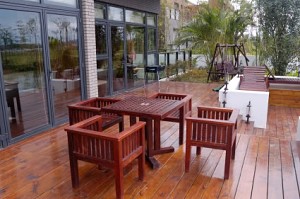Wood Deck Construction: What to Know Before You Build

A home with a well-built deck will nearly always have more value than an identical home without one. Not only can a deck add some architectural style to a home, it adds living space at a price well below the price of an enclosed addition. I have put together some information on what you need to know before you embark on wood deck construction. Some simple guidelines here will help make your wood deck construction project go smoothly.
Construction or Reconstruction
Wood deck construction can fall into two basic categories: The first is a brand new deck where one did not exist before. This is often called a green field project, because it rises up from your "green field," or lawn. The second is where an existing deck is rebuilt. Here, it can be identical in size, larger or even smaller.
Freestanding or Attached
For both of these builds, decks can be either freestanding or attached to an existing structure. Freestanding decks have some advantages. One is the ability to access all sides of the project; another is that most freestanding decks are low to the ground and often do not have railings and other more complicated components. Some jurisdictions also have simpler requirements for foundations and structural elements in freestanding decks.
Decks that are attached to homes are sometimes more cost-effective to build, as they can share support from the house itself and usually only need foundation work or piers at one end. Most wood deck constructions will require a permit, so it's a good idea to start there.
Permits
Check with your local building department to see what requirements are in place. It is always better to start on the right foot with anyone that can make or break your deck project. Some of the requirements that may be in place for your project include: footer depth, setbacks to property lines, materials of construction and design strength (snow load etc). As part of the permitting process, plans or drawings are usually required. In my county, we have requirements for all of these, plus, depending on location, requirements for building with combustion-resistant materials.
Materials
I have always been a fan of real wood decks and have not seen many of the synthetics and composites that can compete with the natural and varied beauty of real wood grain. There are, however, some new composites that are getting very close. One of the benefits of composite decks lies in the lack of regular maintenance that they need. This is great for a busy homeowner who would rather entertain on his deck than spend time staining and oiling.
When I was growing up, wood decks were built from just a handful of woods: pressure-treated and plain pine, cedar and redwood. Today, in addition to those, you can get some great hardwoods such as Ipe, Tigerwood, Garapa, Cumaru, Brazilian Redwood, Teak, Jatoba, Meranti, Cambara, Angelim Pedra and Mangaris, just to name a few. These woods often carry higher prices, but they make up for it in beauty and longevity. Some people say Ipe can last 50 to 60 years in all kinds of environments, while a typical pine deck lasts about 8-10 years. I rebuilt my deck with Ipe over 10 years ago, and it is just as smooth to my bare feet today as it was then. I spend one weekend every 18 months with a brush and some Penofin to maintain the rich brown color I love. Another option is to let Ipe weather to the natural gray found at some of the more famous boardwalks that use this wood. Either way it’s a great choice for decking, and with a number of suppliers providing FSC certifications, you can feel good about using a natural and renewable resource.
Looking for a Pro? Call us (866) 441-6648

Carpentry Average Costs
Carpenters Experiences

Professional Stain Adds The Finishing Touch To My New Cedar Deck

My Deck Repair Was Simple But Perfect



